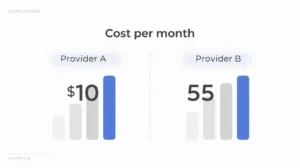Introduction: Why “Affordable” Phone Numbers Matter in 2025
Every small business owner knows this pain: you spend hours building ads, running campaigns, and setting up customer funnels — yet when the phone rings, you realize it’s the most expensive part of your operation.

In 2025, communication costs still eat a major chunk of marketing budgets, especially for service-based businesses that rely on inbound calls. Between toll-free lines, call forwarding, and virtual number subscriptions, the monthly bill can easily spiral beyond reason.
That’s why searching for affordable phone numbers for business has become a smart move rather than a penny-pinching tactic. When done right, it’s not just about saving money — it’s about scaling communication efficiently, tracking leads, and giving your brand a local or global presence without extra overhead.
In this comprehensive guide, we’ll explore:
-
What business phone numbers actually cost and why prices vary so much.
-
The difference between virtual and traditional numbers.
-
Where to find trustworthy yet low-cost providers.
-
Real examples of cost savings using call tracking tools like VoiceTotal.
-
A full setup checklist to keep your costs predictable and your performance measurable.
Let’s start by understanding what “affordable” really means when it comes to phone systems in 2025.
What Are Business Phone Numbers (and Why Do They Matter)?
A business phone number is more than just a contact line. It’s often the first touchpoint between you and your customers. It represents credibility, accessibility, and professionalism.
Traditional vs. Virtual Phone Numbers
| Type | Description | Typical Monthly Cost | Best For |
|---|---|---|---|
| Traditional Landline | Physical wired connection through telecom provider | $25–$60 per line | Local retail stores, small offices |
| VoIP / Cloud Number | Internet-based number accessible via apps or web | $5–$20 per line | Startups, remote teams |
| Toll-Free Number (800, 888, etc.) | Free for callers, ideal for national reach | $15–$40 | Nationwide service providers |
| Local Virtual Number | Mimics a specific area code (e.g., +65, +1 212) | $3–$10 | Local SEO & marketing |
| Call Tracking Number | Unique number used to measure marketing source ROI | $2–$8 | Digital marketers, agencies |
Modern businesses — especially those running multi-channel campaigns or remote operations — increasingly prefer virtual or VoIP-based business numbers. These systems offer flexibility, scalability, and integration with CRM tools.

Instead of being tied to a desk phone, team members can answer or forward calls via a web browser, mobile app, or dashboard. This ensures that no customer inquiry goes unanswered — whether you’re in the office or on the go.
Ultimately, your business number is the gateway to customer experience. By choosing the right setup — from VoIP to call tracking — you can enhance communication, track ROI, and create a consistent professional image across every channel.
Why Affordable Business Numbers Are Essential for Growth
When building a modern business, communication is everything — but that doesn’t mean it has to be expensive. Affordable business phone numbers give companies of all sizes the flexibility, scalability, and professionalism they need without draining their budgets. Choosing cost-effective options isn’t about cutting corners; it’s about maximizing efficiency and smart resource allocation.
1. Lower Overhead
Every dollar saved on traditional telecom costs can be redirected into more impactful areas like digital marketing, customer retention, or new product development. Affordable VoIP or virtual numbers eliminate the need for bulky hardware and maintenance fees, helping small and growing businesses operate lean.
2. Flexibility
Unlike traditional landlines, cloud-based numbers allow you to add, remove, or reassign lines instantly. No expensive contracts, no technician visits — just quick, scalable control from your dashboard.
3. Scalability
Expanding into new cities or markets? Affordable local area code numbers help build regional trust and make customers feel they’re dealing with a nearby, reliable brand. It’s a subtle but powerful way to boost conversions.
4. Call Tracking & Analytics
When paired with modern platforms like VoiceTotal, affordable numbers become a data goldmine. You can track which marketing channels drive the most calls, monitor agent performance, and even measure campaign ROI — all through one simple system.
For more tips on call tracking and phone numbers, explore our blog 7 Key Benefits of Call Tracking for Your Business
5. Professional Branding
Even solo entrepreneurs can appear established and trustworthy by using dedicated business lines instead of personal numbers. It enhances your brand image and builds customer confidence.
Fun fact: A Harvard Business Review study found that 82% of customers still prefer calling a business before making a major purchase.
In short, affordable business numbers aren’t just a cost-saving tool — they’re a strategic investment that supports communication, growth, and credibility in a competitive marketplace.
The Real Cost Breakdown of Business Phone Numbers
Understanding the true cost of a business phone number is crucial for making informed, long-term communication decisions. While prices may seem similar across providers, the total cost depends on multiple factors — from the type of number you choose to the advanced features you enable. Let’s explore what truly drives pricing and how to find the right balance between affordability and functionality.
1. Type of Number
Not all numbers are created equal. Local numbers are often the most affordable, while toll-free and vanity numbers typically cost more due to their nationwide accessibility and memorability. Businesses that prioritize brand recognition may justify the higher cost for a vanity line.
2. Usage Volume
Your call volume directly impacts your bill. Most providers charge either by the minute or offer flat monthly subscriptions. For businesses with predictable traffic, unlimited plans provide better control over expenses.
3. Feature Bundle
Modern communication tools go beyond voice. Add-ons like call recording, IVR (Interactive Voice Response) menus, voicemail transcription, or AI-based analytics can increase the monthly fee — but they also boost efficiency and customer satisfaction.

4. Geographic Coverage
Costs can vary based on region. Numbers in highly competitive or regulated markets like the US, UK, and Singapore may carry slightly higher rates. Still, cloud-based systems make it easy to manage global coverage under one account.
5. Provider Infrastructure
Some providers still rely on traditional telecom infrastructure, while others operate fully via VoIP (Voice over Internet Protocol). The latter often offers more flexible pricing and advanced analytics.
Pro Tip: For most small businesses, $5–$10 per month per number is sufficient for a VoIP-based local or tracking line.
For a detailed comparison of pricing and features, visit Forbes’ Best Business Phone Systems of 2025

